Caballero B. (ed.) Encyclopaedia of Food Science, Food Technology and Nutrition. Ten-Volume Set
Подождите немного. Документ загружается.

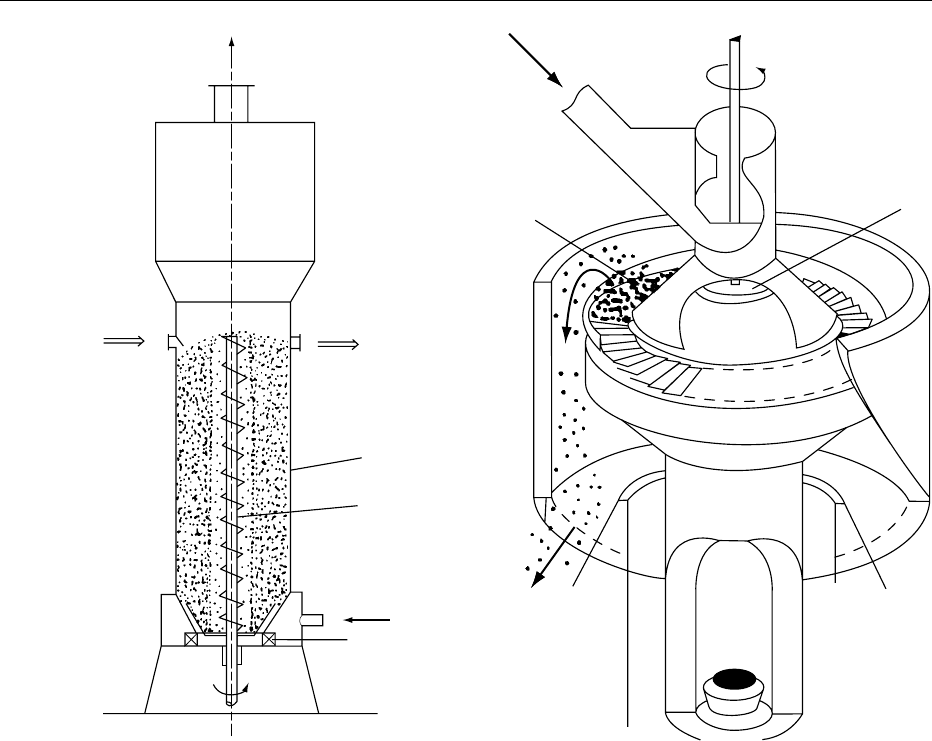
pressure drop has to be developed across the bed to
form the spout. Once this is formed the pressure drop
decreases to a value less than that which develops
across a conventional fluidized bed. A spouted-bed
drier featuring tangential air inlet has also been
reported (Figure 5). The air enters through slits at
the bottom of the chamber. An open screw conveyer
is located in the spout to control the upward move-
ment of the particles, independently of the air vel-
ocity. This enables smaller particles to be dried as
compared with a conventional spouted-bed drier. A
high early air pressure drop is not required to initiate
spouting. Wheat, corn, and diced carrot are among
the foods which have been successfully dried in
spouted-bed driers.
Toroidal-bed Drier
0011 This is another novel design of fluidized-bed drier
(Figure 6). A high-velocity stream of heated air enters
the base of the process chamber through blades or
louverswhichimpartarotarymotiontotheair.This
creates a compact rotating bed of particles, which may
vary in depth from a few millimeters to 50 mm. High
rates of heat and mass transfer are attainable in this
bed, resulting in high initial rates of drying. This drier
can accommodate a wide range of particle sizes and
shapes and can be operated on a batch or continuous
basis. Not much information on the performance of
this equipment for drying foods has been published.
However, preliminary studies, in which this author has
participated, indicate that it has considerable potential
for drying small particulate foods and liquid foods on a
similar principle to the spouted bed above. It can be
used for roasting products such as coffee beans and
nuts, expanding pasta pellets, and possibly cooking or
sterilizing other particulate. In a current study it is
being used to produce puffed potato cubes.
Air
Wet material
Dry product
3
2
Air
1
fig0005 Figure 5 Spouted-bed drier with tangential air inlet and central
conveyor screw: 1, tangential air inlet; 2, conveyor screw; 3, drier
body. From Mujumdar AS (ed.) (1995) Handbook of Industrial
Drying, 2nd edn, by courtesy of Marcel Dekker: New York.
Product
4
1
2
3
Feed
fig0006Figure 6 The toroidal-bed drier: 1, rotating disk distributor to
deliver raw material evenly into the processing chamber; 2,
rotating bed of particles; 3, fixed blades with hot air passing
through at high velocity; 4, burner assembly. From Brennan JG
(1994) Food Dehydration ^ A Dictionary and Guide. Oxford:
Butterworth-Heinemann with permission.
1926 DRYING/Fluidized-bed Drying

Centrifugal Fluidized-bed Drier
0012 This consists of a cylindrical chamber rotating about
a horizontal axis (Figure 7). The cylinder wall is
perforated and a high-velocity (up to 15 m s
1
) stream
of air flows through these perforations and across the
drying chamber. The feed enters at one end of the
chamber and the dried product leaves over a weir at
Product
Discharge weir
Rotation
Product
Cross air flow
Perforated cylinder
feeder
fig0007 Figure 7 Centrifugal fluidized-bed. From Mujumdar AS (ed.) (1995) Handbook of Industrial Drying, 2nd edn, by courtesy of Marcel
Dekker: New York.
Solids
discharge
Atomizing nozzle
Sliding mesh
Regulating
valve
Pitot
tube
Air
Liquid
Heater
Com
p
ressor
Fine mesh
Spout
deflector
Perspex
window
Spouted bed
drier
Cyclone
fig0008 Figure 8 Experimental spouted-bed drier for liquid foods. From Ochoa-Martinez AE, Brennan JG and Niranjan K (1993) Spouted bed
dryer for liquid foods. Food Control 4: 41 – 45 with permission.
DRYING/Fluidized-bed Drying 1927

the other end. Some 10–20% of the chamber volume
is occupied by the food particles. These are made to
fluidize during part of each revolution and form a
stationary bed during the rest of the cycle. This drier
has been used to dry sliced and shredded vegetables
which are difficult to dry in conventional fluidized-
bed driers and for puffing vegetable pieces, including
rice grains, to produce a quick-cooking product.
Novel Applications for Fluidized and
Spouted Beds
0013 Fluidized beds of inert particles have been used to dry
solid and liquid food materials. A whirling fluidized
bed of glass beads has been used to dry diced vege-
tables and sticky products such as cooked rice. Mush-
rooms, carrot, beef, and shrimp have been dried
at low temperature in a fluidized bed of activated
alumina. Paste and liquid foods have been dried in
spouted beds of inert particles. Blood has been dried
in this way. In a recent study, model liquid foods were
sprayed on to polypropylene beads in an experimen-
tal spouted bed drier (Figure 8). Drying occurred by a
combination of convected heat from the air and con-
ducted heat from the beads. The performance of this
drier was compared with that of a laboratory spray
drier. Early results indicated that the drying process in
the spouted bed was rather more severe than in the
spray drier. However, the evaporative capacity of the
spouted bed was some six times that of the spray
drier, which was a comparable size.
0014Fluidized beds may be used to produce agglomer-
ated or granulated products. A liquid is sprayed on to
a fluidized bed of particles, coating them. Collisions
between particles cause them to adhere together to
form agglomerates. When the agglomerates reach the
desired size they are dried to a stable moisture content
by raising the temperature of the fluidizing air. Both
batch and continuous agglomerating systems are
available (Figure 9).
0015A relatively new application for fluidized beds is
the puffing of fruit and vegetable pieces. The pieces
Police filters
Spraying system
Inlet air
filter
Inlet air
filterHumidifier
Heater Cooler
HEPA
HEPA
Product filters
Filter housing
Expansion zone
Product container
Air distributor
Inlet air plenum
Control panel
Fan
fig0009 Figure 9 Batch fluidized-bed agglomerator. Courtesy of Niro Aeromatic AG.
1928 DRYING/Fluidized-bed Drying

are predried in a conventional hot-air drier such as a
cabinet or tunnel, to form an impervious layer on
their surface. They are then introduced into a fluid-
ized bed, operating at a relatively high temperature.
The water evaporates internally within the pieces,
causing them to expand and producing an open
porous structure. The puffed product is then dried
down to a stable moisture content in a cabinet or
tunnel drier. This has the effect of reducing the overall
drying time and produces a product which reconsti-
tutes rapidly. Alternatively, the dry product may be
used as a snack food, low in fat, compared with fried
products.
Drying Difficult Materials
0016 To contain hazardous materials or unpleasant odors
semiclosed-cycle fluidized-bed systems are available.
In such systems a large proportion of the exhaust air
is recycled. The air from the cyclones goes to a con-
denser/scrubber which removes the water from it as
condensate. Only a small amount of air is released to
the atmosphere; the rest is recycled through the heater
and drier. The air vented from the system may be
burnt off if necessary. Similar systems are available
for spray driers. Application of these specialized types
of driers to food dehydration is limited at the present
time. However, as regulations relating to pollution of
the environment become more stringent, the use of
such systems may increase.
See also: Drying: Theory of Air-drying; Physical and
Structural Changes; Chemical Changes
Further Reading
Brennan JG (1994) Food Dehydration – A Dictionary and
Guide. Oxford: Butterworth-Heinemann.
Brennan JG Butters JR, Cowell ND and Lilly AEV (1990)
Food Engineering Operations, 3rd edn. London: Else-
vier Applied Science.
Filkova I and Mujumdar SS (1995) Industrial spray drying
systems. In: Mujumdar AS (ed.) Handbook of Industrial
Drying, 2nd ed, pp. 263–307. New York: Marcel Dekker.
Hovmand S (1995) Fluidized bed drying. In: Mujumdar AS
(ed.) Handbook of Industrial Drying, 2nd edn, pp.
195–248. New York: Marcel Dekker.
Ochoa-Martinez LA, Brennan JG and Niranjan K (1993)
Spouted bed dryer for liquid foods. Food Control 4:
41–45.
Pallai E, Szentmarjay T and Mujumdar AS (1995) Spouted
bed drying. In: Mujumdar AS (ed.) Handbook of Indus-
trial Drying, 2nd edn, pp. 425–488. New York: Marcel
Dekker.
Varnalis A, Brennan JG and MacDougall DB (1998) Puffing
of foodstuffs – a review. European Food and Drink
Review winter 23–26, 28–31.
Spray Drying
J G Brennan, University of Reading, Reading, UK
Copyright 2003, Elsevier Science Ltd. All Rights Reserved.
Principles
0001This is the most commonly used method for drying
food liquids and some slurries. The feed is converted
into a fine mist or spray which is then mixed with
heated air. Very rapid drying takes place, converting
the liquid droplets into powder particles. Because
of the small size of the particles – diameters usually
in the range 10–200 mm – a very large surface area is
available for drying. Also the distance that moisture
has to migrate within the particles to the drying
surface is relatively small. Thus, short drying times,
1–20 s, are a feature of this method of drying. There is
also a significant evaporative cooling effect so that
the surface temperature of the droplets does not rise
much above the wet bulb temperature of the drying
air until drying nears completion. Provided the par-
ticles, once dry, are swiftly removed from the drying
chamber, heat damage to the product can be limited.
0002The main features of a single-stage spray-drying
plant are shown in Figure 1. Inlet fan A draws air in
through a filter B and pushes it through the air heater
C into the drying chamber D. By means of pump E the
feed material is pumped from feed tank F to the spray-
forming device G. It is converted into spray which
mixes with the drying air in the drying chamber D.
The bulk of the dry powder thus formed is removed
from the drying chamber via valve H and is carried
pneumatically to a storage bin through duct I. The air
is removed from the drying chamber via ducting J
through one or more air/powder separators K and is
exhausted to the atmosphere by outlet fan L. The fine
powder recovered by the separators K may be added
to the main product stream via valve M or recycled
into the wet zone of the drying chamber via duct N.
Spray-drying Equipment
0003Air heating may be indirect using steam, fuel oil, or
gas. Direct heating would obviously improve the ther-
mal efficiency of a drier and in recent years natural
gas has been used directly to heat the incoming air.
There is some concern over the possible contamin-
ation of the dried products with nitrate and nitrite
compounds and N-nitrosodimethylamine. The intro-
duction of low NO
x
(nitrogen oxide) burners has
reduced this problem. However, work is still in pro-
gress to establish the level of contamination, if any, of
food products dried by directly heated air.
DRYING/Spray Drying 1929
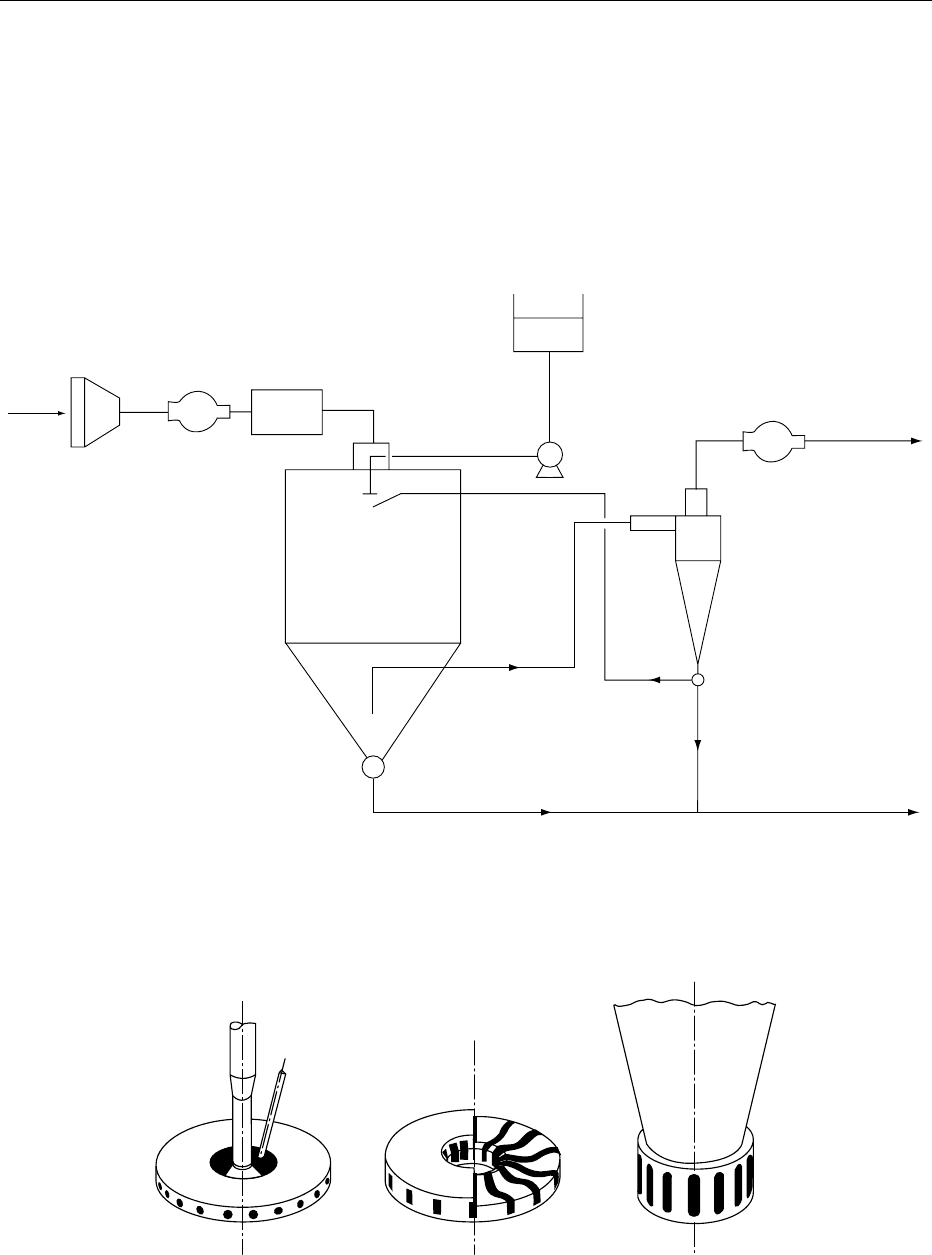
0004 The formation of a spray of the feed liquid within a
specified size range is an essential feature of spray
drying. Too wide a droplet size range can lead to
nonuniform drying and/or build-up of powder on
the inner wall of the chamber. Droplet size can influ-
ence important properties of the dried product such
as its bulk density and reconstitution characteristics.
0005 Spray-forming devices, also known as atomizers,
are of three general types: (1) centrifugal or wheel
atomizers; (2) pressure nozzles or jets; and (3) two-
fluid or pneumatic nozzles.
0006A centrifugal atomizer consists of a disk or bowl on
the end of a rotating shaft. The liquid feed is intro-
duced on to the disk near its center of rotation. It
accelerates to the peripheral velocity of the disk and
is spun off, in the form of a spray, into the drying
chamber. There are numerous different designs of
spinning disk, some of which are depicted in Figure 2.
B AC
D
H
M
N
K
E
L
F
G
J
I
fig0001 Figure 1 A typical single-stage spray drier, featuring recycling of fines. A, air inlet fan; B, filter; C, air heater; D, drying chamber; E,
feed pump; F, feed tank; G, atomizer; H, rotary valve; I, product conveyor; J, duct for outlet air; K, cyclone, L, air outlet fan; M, rotary
valve; N, duct for returning fines to chamber. From Brennan JG (1994) Food Dehydration ^ A Dictionary and Guide, Oxford: Butterworth-
Heinemann with permission.
Circular vanes Rectangular curved vanes Oval vanes
fig0002 Figure 2 Different designs of centrifugal atomizers. Adapted from Mujumdar AS (1995) Handbook of Industrial Drying, 2nd edn. New
York: Marcel Dekker with permission.
1930 DRYING/Spray Drying

Disk diameters range from 50 to 300 mm, they rotate
at speeds of 50 000–10 000 revolutions per minute,
respectively, and produce droplets with mean diam-
eters in the range 1–600 mm. Centrifugal atomizers
can produce uniform sprays within a wide range of
droplet sizes. The size distribution of the droplets can
be altered by changing the speed of rotation. Such
atomizers are not subject to blocking or abrasion due
to insoluble solid particles in the feed and can handle
viscous materials at low pumping pressures.
0007 A pressure nozzle (Figure 3a) features a small ori-
fice, with a diameter in the range 0.4–4 mm, through
which the feed is pumped at high pressure, in the
range 5–50 MN m
2
. A grooved insert, located
behind the orifice, imparts a spinning motion to the
liquid, producing a hollow cone of spray. Pressure
nozzles can produce quite uniform droplets with
mean diameters ranging from 10 to 800 mm, which
usually results in dried particles with hollow centers.
The orifices in such nozzles may be abraded or
blocked by insoluble solid particles in the feed. Very
high pumping pressures are required to atomize
viscous liquids.
0008 In a two-fluid or pneumatic nozzle (Figure 3b) the
energy in a high-velocity stream of gas is used to
atomize the feed. The gas exits from the nozzle
through an annular opening while the liquid feed
exits through a circular opening concentric with the
annular one. A Venturi effect is created and the liquid
is converted into a spray. Such nozzles are subject to
blocking and abrasion by solid particles in the feed.
The size of the droplets can be changed by varying the
gas–liquid ratio. They have relatively small capacities
and can produce a spray with a broad spectrum of
droplet sizes, especially with high-viscosity feeds.
0009 A recent development involves the use of sonic
energy to atomize highly viscous materials. A sonic
resonance cup is located in front of a two-fluid
nozzle. This creates a field of high-frequency sound
waves that breaks up the liquid into droplets. This
system is not yet being used commercially.
0010 In the drying chamber of a spray drier the spray of
feed contacts the heated air and drying takes place.
There must be sufficient dwell time in the chamber for
the particles to reach a suitably low moisture content
but, once that is attained, the dry particles must be
removed quickly from the chamber to avoid unneces-
sary heat damage. There are many designs of drying
chamber available. These may be classified into three
groups based on the direction of flow of the feed
relative to the air, i.e., concurrent, countercurrent,
and mixed flow. Countercurrent chambers are seldom
used for food applications because of the risk of heat
damaging the product. Concurrent chambers usually
consist of a cylindrical body with a conical base.
When drying large droplets of a heat-sensitive feed,
in particular if the dried particles are tacky and tend
to adhere to the wall of the chamber, a tall cylindrical
body is used (Figure 4a). The feed is introduced at the
top of the chamber, usually through a nozzle atom-
izer, and follows a fairly straight-line flow path to the
bottom of the chamber. The wall of the conical
section of the chamber may be cooled to facilitate
removal of the powder.
0011Other concurrent chambers feature a shorter cylin-
drical body (Figure 4b). The air enters at the top of
the chamber tangentially and follows a downward,
spiral flow path. The liquid feed enters at the top of
the chamber through a centrifugal atomizer. This
design of drying chamber is widely used for drying
foods which are not very heat-sensitive or tacky. A
mixed-flow chamber features both concurrent and
countercurrent flow patterns (Figure 4c). Such cham-
bers find limited application in the food industry. The
risk of heat damaging the product is greater than in
concurrent chambers. Many other types of chamber
are available, including flat-bottomed cylindrical and
horizontal box-like designs.
0012In industrial-sized spray driers the bulk of the dried
powder is removed directly from the chamber through
a rotary valve or vibrating device. Some food powders,
mainly those with high sugar or fat contents, become
sticky when hot and adhere to the wall of the cham-
ber. Various devices are available to assist in the
removal of such products. Hammers may be made
to strike the outside wall of the chamber at intervals
(a) (b)
Liquid
Air
fig0003 Figure 3 (a) Pressure nozzle; (b) two-fluid or pneumatic nozzle. Adapted from Brennan JG, Butters JR, Cowell ND, Lilly AEV (1990)
Food Engineering Operations, 3rd edn. London: Elsevier Applied Science with permission.
DRYING/Spray Drying 1931
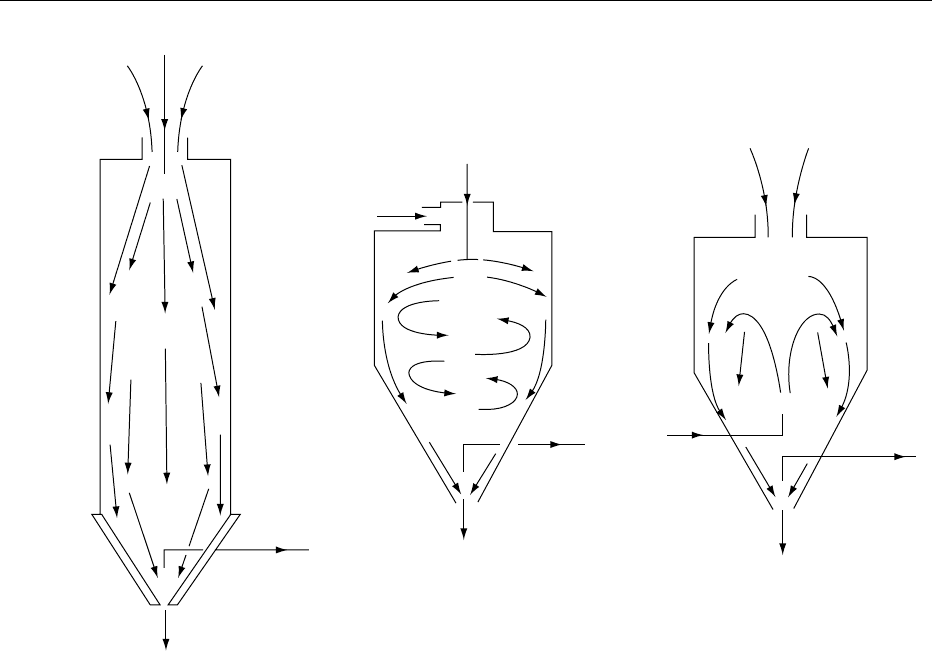
to loosen deposits. Brushes, chains, or air brooms
may sweep the inner surface of the chamber. Redu-
cing the temperature of the chamber wall may help.
This can be achieved by removing some of the insula-
tion from the wall or by drawing cool air in through a
jacket covering some or all of the chamber wall
(Figure 4a). This warm air may then be introduced
into the main air supply to the heater, thus recovering
some of the heat lost from the chamber. Fine powder
entrained in the exhaust air from the chamber may be
recovered with the use of dry cyclone separators,
filters, or wet scrubbing devices, singly or in various
combinations. If some of the feed is used to wash the
outgoing air in a scrubber and is then recycled as feed
into the drier, savings in energy can result.
0013 Semiclosed or closed spray-drying systems are
available in which some or all of the drying gas is
recycled. A scrubber-condenser is used to remove the
water vapor from the gas. These systems may be used
for drying materials with strong, unattractive odors
or where gases other than air are used as the drying
medium. Aseptic spray-drying systems are also avail-
able in which all the air entering the system is pre-
sterilized, usually by filtration, and the product is
discharged into a sterile packing zone. Such systems
are mainly used in the pharmaceutical industry but
may find applications in food dehydration as hygienic
requirements become more stringent.
Safety Considerations
0014There are fire and explosion hazards associated with
spray drying of liquid foods. A dust explosion may
occur when a fine combustible powder is dispersed in
air and ignited. For an explosion to occur there must
be a sufficient concentration of powder in the air and
sufficient oxygen present to support combustion.
Such conditions may exist in spray driers under
normal operating conditions. Self-ignition may
occur in food powders. Oxidative reactions are exo-
thermic and the generation of heat by such reactions
can be very fast at the temperatures encountered in
spray drying. In thick layers of powder, heat gener-
ated in this way cannot escape quickly enough and
the temperature rises rapidly, causing ignition. The
critical thickness for ignition depends on the tempera-
ture and the powder characteristics. Obviously, to
minimize the occurrence of self-ignition, the build-up
Product out
Air out
Cooling jacket
(optional)
Feed in
Air in Air in
Feed in
Air in
Air out
Product out
Product out
Air out
Feed in
Air in
(a) (b) (c)
fig0004 Figure 4 Different designs of spray-drying chambers: (a) concurrent with straight-line flow path; (b) concurrent with spiral flow path;
(c) mixed flow.
1932 DRYING/Spray Drying
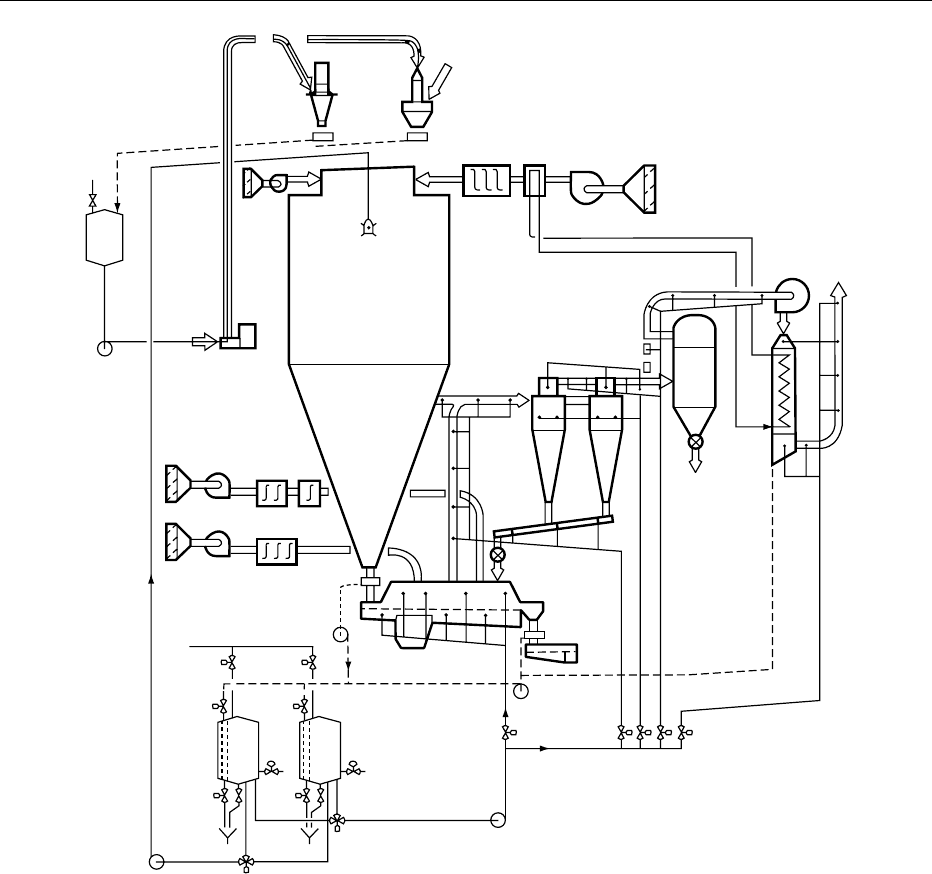
of layers of powders in spray-drying systems should
be avoided. Regular and efficient cleaning of the plant
(see below) and the use of devices, such as those
mentioned above, to remove powder deposits can
reduce the hazard. There may be other causes of
powder ignition such as heat generated by friction
or electrical sparks. In spray driers featuring direct
flame heating, very hot particles entering the drier in
the heated air may ignite the powder. Good design
and maintenance of equipment should minimize the
chances of ignition occurring by these means. The
fitting of weaker doors or panels, which are designed
to fail at relatively low pressures, relieving the explo-
sion, is the most common precaution taken to limit
damage due to dust explosions in spray driers. Other
measures such as containment or suppression of such
explosions are not usually feasible in high-capacity
driers.
0015Efficient cleaning of spray drier installations is
essential. This may be done manually using high-pres-
sure water jets. Rotating nozzle heads may be strategic-
ally located throughout the system so that all parts of
the equipment are contacted by the cleaning fluid.
Most modern plants are equipped for cleaning-in-
place (CIP). Such a system is shown in Figure 5.
Energy Considerations
0016Spray drying is an energy-intensive method of remov-
ing moisture. In a straight-through spray drier, up to
fig0005 Figure 5 Cleaning-in-place (CIP) system for spray drier layout. From Masters K (1991) Spray Drying Handbook, 5th edn. New York:
Longmans with permission.
DRYING/Spray Drying 1933
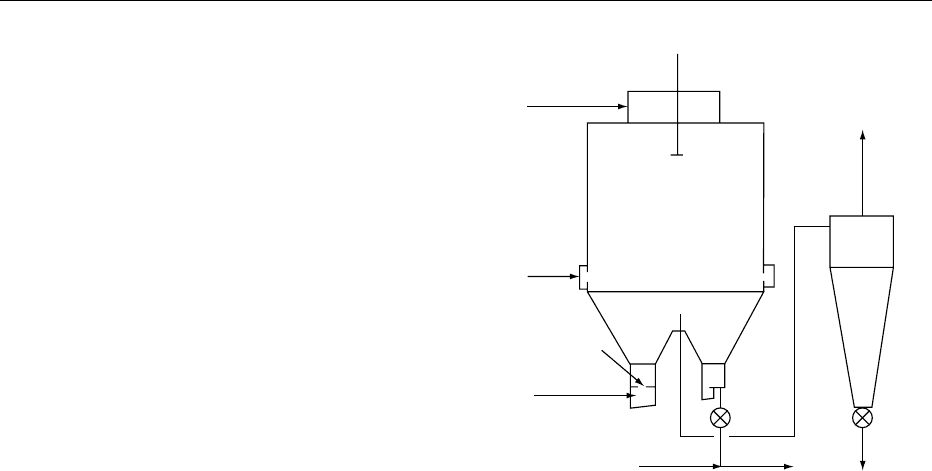
6000 kJ of energy may be required to evaporate 1 kg
of water. By comparison, in a six-stage multiple-effect
evaporator with mechanical recompression, as little
as 200 kJ may do the same task. Therefore, to con-
serve energy, liquid foods should be concentrated to
as high a solids content as possible prior to spray
drying. The upper limit of solids concentration is
usually determined by the viscosity of the concentrate
which, if too high, may result in poor atomization.
The use of direct flame heating of the air to the spray
drier is more energy-efficient than indirect methods
(see above). The higher the air inlet temperature and
the lower the air outlet temperature, the more ther-
mally efficient the drying operation. The upper limit
on air inlet temperature is usually determined by the
heat sensitivity of the feed. For many foods 200
Cis
this upper limit. Some can tolerate 250
C. It is now
possible to go as high as 300
C for some foods when
using modern, multistage spray-drying systems (see
below). A low outlet temperature may lead to too
high a moisture content in the product. Few driers
operate well below 80
C. Up to 50% of the exhaust
air from the drying chamber may be recycled under
certain circumstances and can lead to up to a 20%
saving in energy. However, this must be balanced
against a reduction in evaporative capacity and is
really only feasible when high air outlet temperatures
are used. Thus, it is not suitable if the product is heat-
sensitive. Recovery of heat from the exhaust air leav-
ing the drying chamber offers another opportunity to
conserve energy. This may be achieved using air/air
heat exchangers so that the incoming air is pre-
warmed with heat recovered from the exhaust air.
There have been considerable improvements in the
design of such heat exchangers in recent years. Alter-
natively, heat recovered from the exhaust air may be
used to prewarm the liquid feed to the drier. This can
be achieved by the use of wet scrubbers to wash the
fines from the exhaust air (see above).
Finishing Operations
0017 In the case of some powders, better control over
product quality may be achieved by removing it
from the main spray-drying chamber at a moisture
content higher than the desired final value and finish-
ing the drying in another type of drier. Vibrating
fluidized-bed driers are most commonly used for
this purpose. In this secondary drier some agglomer-
ation of fine powder particles may occur, reducing the
amount of very fine particles in the end product. If the
fine powder recovered from the cyclones is recycled
into the wet zone of the drying chamber, this will
further reduce the amount of very fine particles in the
product (Figure 1). Such a reduction usually facili-
tates the handling of the dry powder and improves its
reconstitution characteristics. The use of such second-
ary driers can also lead to savings in energy as com-
pared with single-stage drying. The powder leaving
the secondary drier may be cooled in another vibrat-
ing fluidized bed.
0018Spray driers are also available which permit multi-
stage drying in one unit. One design features a built-in
fluidized bed (Figure 6). This bed is in the shape of a
ring at the bottom of the chamber. Heated air is
introduced at the top of the chamber and also at the
bottom, fluidizing the particles in the annular bed.
Drying takes place partly in the main chamber and
partly in the fluidized bed. A further supply of air is
introduced tangentially into the chamber. This sweeps
the wall of the chamber, reducing powder build-up
and improving air/powder separation. In the Filter-
mat drier (Figure 7) part of the drying takes place in
the main chamber and the semidried powder falls on
to a perforated, moving belt where it is dried to the
required moisture content in two further stages, with
a short holding period between, by a through flow of
warm air.
0019Spray-dried products containing very fine particles
may be difficult to reconstitute. When added to hot
coffee, for example, dried milk powder may form
clumps which float on the surface of the liquid and
require vigorous and prolonged stirring to disperse.
The most common solution to this problem is to
F
A
A
A
Static
fluid bed
AP
P
A
fig0006Figure 6 A two-stage layout with integrated static fluid bed in
drying chamber: A, air flow; F, feed; P, dried product. From
Masters K (1991) Spray Drying Handbook, 5th edn. New York:
Longmans with permission.
1934 DRYING/Spray Drying
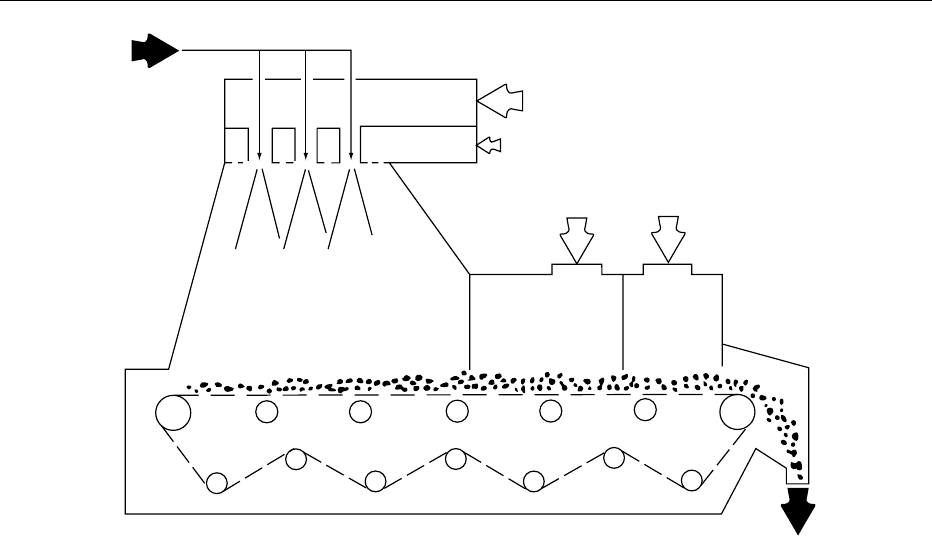
increase the size of the powder particles. This may be
achieved by adjusting the drying conditions, by recyc-
ling of fines, or by agglomeration in a secondary drier
(see above). When these measures are inadequate,
instantizing may be effected by rewetting the surface
of the particles with steam, warm humid air, or a fine
mist of liquid, promoting interparticle collisions by
swirling the wetted powder in a vortex and redrying
the agglomerated powder, often in a fluidized-bed drier.
Control of Spray Driers
0020 Most modern spray driers are equipped with auto-
matic control systems. The main parameter which is
controlled is the outlet air temperature. In the case of
driers equipped with rotary atomizers, the outlet air
temperature is controlled by adjusting the rate at
which the feed enters the chamber. The air inlet tem-
perature is separately controlled by adjusting the fuel
supply. When nozzle atomizers are in use, the feed
rate needs to be constant, and the outlet air tempera-
ture is controlled by adjusting the combustion rate of
the fuel. In both cases, an additional safety device
must be fitted to avoid a rapid rise in outlet tempera-
ture should there be an unexpected drop in the feed
rate. In addition to the above controls, the starting-
up, shutting-down, and cleaning of the plant may be
controlled by timing devices.
Spray-Dried Food Products
0021A very wide range of spray-dried food products is
produced worldwide. A summary of typical operating
conditions and some properties of a selection of dried
powders is presented in Table 1.
Dairy Products
0022Skim milk is spray dried on a very large scale:
some plants handle more than 1 million liters of
milk per day. It is not a difficult material to spray
dry with no tendency to adhere to the chamber
wall and not being very hygroscopic. Many designs
of drying chamber are used, featuring both centri-
fugal and nozzle atomizers. Skim milk powder
produced in a simple single-stage drier contains a lot
of fine particles, is dusty, and is difficult to handle
and reconstitute. These properties can be improved
by recycling fines, promoting agglomeration in
secondary driers or integral fluidized beds or by
rewetting.
0023Whole milk is rather more difficult to dry. It tends
to be rather sticky when hot and can build up a
deposit on the chamber wall. Hammers or other
devices (see above) to assist in the removal of such
deposits can be used. Handling and reconstitution
characteristics can be improved by agglomeration.
In addition, the dried particles may be coated with
7
1
2
3
45
6
8
9
fig0007 Figure 7 Filtermat spray dryer (DEC): 1, feed to nozzles; 2, primary drying air; 3, ceiling cooling air; 4, secondary drying air; 5,
cooling air; 6, textile mesh belt conveyor; 7, powder layer; 8, exhaust air to cyclone; 9, product outlet. From Mujumdar AS (1995)
Handbook of Industrial Drying, 2nd edn. New York: Marcel Dekker with permission.
DRYING/Spray Drying 1935
